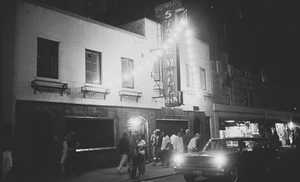Stonewall Inn: Through the Years
From the Collection: The LGBTQ+ experienceA revered landmark for American gay rights activists, Greenwich Village's Stonewall Inn has undergone several transformations in the decades since it was the focal point of a three-day riot in 1969. Once a safe haven where the city's homosexuals could drink and dance free from harassment, the site fell into disrepair following the riots. Today, Stonewall Inn is open once again, for a drink, a dance, or a quick lesson in history.

Before the June 1969 riots, the Stonewall Inn on Christopher Street was a typical New York City Mafia-run bar: patrons drank over-priced, watered-down, and often bootlegged liquor; there was no running water; and the bar's two dark rooms were often uncomfortably stuffy and hot. It was a dive bar, but one in which the city's homosexuals felt comfortable and at home. As Jerry Hoose, Stonewall patron and founding member of the Gay Liberation Front described, "The bar itself was a toilet, but it was a refuge, it was a temporary refuge from the street."
As visitors entered the bar, they left their coats at check-in on their left. A set of doors led to the first room where the long, black, plywood bar would, on occasion, support a dressed up go-go dancer. Although the bar served a variety of people, the first room was usually crowded with the chino wearing, more straight-laced patrons looking to have a drink and to chat at the tables lined up along the walls. Those looking to dance entered a set of side doors that led to a second room which contained a large dance floor. The smell of popular perfumes such as Tabu and Ambush filled the room, worn by drag queens. Patrons fed quarters into the jukebox -- usually picking Motown or pop songs -- and danced freely with same-sex partners, a luxury not acceptable in most New York bars. A single white bulb hanging from the ceiling warned patrons of a police raid, at which point everyone would stop dancing and separate so as to avoid a potential arrest for lewd conduct.
On June 28th, 1969 a fairly typical police raid escalated into a three-day riot after the patrons refused to leave the bar. That night, six police officers were pushed back and into the bar by a mob on the street outside. Inside the Stonewall, police and the rioters remained calm as they heard the chaos erupting outside. The bar that police had raided just moments earlier had quickly become their refuge. As officer Pine recalled, "They had a regular entrance which was covered in steel, and it would be very difficult to break in once they closed it. If you had any men in there you had to protect them... you knew the moment you stepped out the door, you knew there'd be hundreds facing you."
After backup arrived police exited the bar, but throngs of people continued to flock to Christopher Street, rising up in support of Stonewall's patrons.
Following the riot, the bar's reputation was tarnished. Gay rights groups advocated boycotting Mafia-run establishments, and police raids continued in Greenwich Village.

With no liquor license Stonewall converted to a juice bar, but the venture failed, and by October 1969, just three months after the raid, the Stonewall Inn was up for lease. In the 70s and 80s, a variety of establishments filled the space: a bagel sandwich shop, a Chinese restaurant, and a shoe store all occupied the building.
By the 1990s, gay bars began to repopulate Christopher Street. The western half of the original space opened as a bar in the early 90s, and in 2007 the entire space was renovated and renamed the Stonewall Inn. The historic significance of the Greenwich Village bar and its impact on the LGBTQ rights movement gained recognition, and the site was added to the U.S. National Register of Historic Places on June 28th, 1999, the 30th anniversary of the riots. On February 16, 2000, the Stonewall Inn became a National Historic Landmark.







